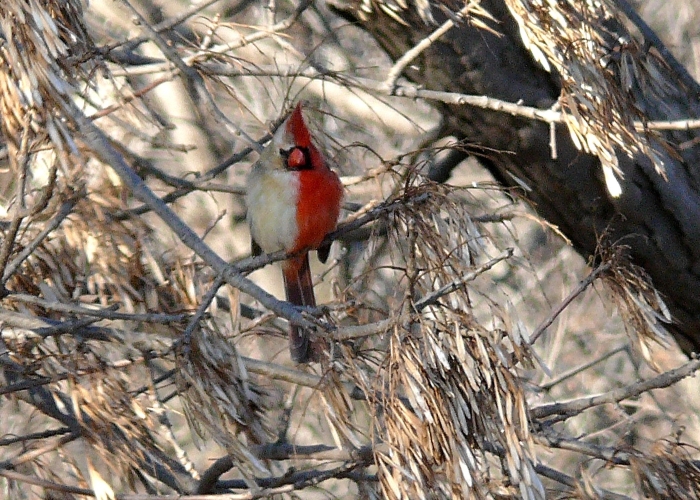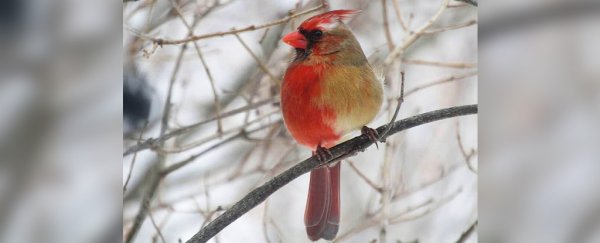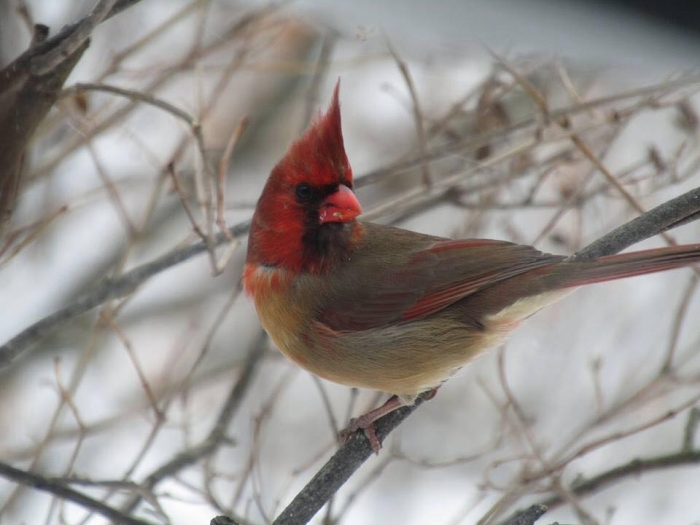Two bird lovers in Erie, Pennsylvania were only expecting to enjoy the company of their colourful feathered friends when they began setting up backyard feeders 25 years ago.
But then the lavish spread attracted an unusual visitor: a northern cardinal (Cardinalis cardinalis) that was half the brilliant vermilion of the male of the species, and half the less ostentatious dun of the female.
Well, guess what. That appearance isn't just plumage-deep. The reason it looks like it's half-male and half-female is because… it actually is.
The phenomenon is called bilateral gynandromorphism, and it's been documented in birds since at least the 1920s, when it was described in a chicken.
"Never did we ever think we would see something like this in all the years we've been feeding," Shirley Caldwell, whose backyard it showed up in, told National Geographic.
Bilateral gynandromorphism is a type of genetic chimerism, whereby a single animal has more than one set of DNA. More specifically, it's a type of tetragametic chimerism, so-named because it involves four (tetra) gametes - two sperm and two ova.
The ova are fertilised separately and start to divide; then, early in the development process, they fuse and become one blastocyst or zygote. In other words, it's a fusing of fraternal twins. (The process presumably occurs with identical twins, too, but since their DNA is identical anyway, we'd have no way of knowing that it took place.)
Now, if one of the ova is male and one is female, the resulting chimera can have the sexual characteristics of both - often split bang down the centre, like someone has cut two animals in half, and stuck one half of each together. This is why they have the nickname "half-siders."
It's been documented in a range of species, including an early paper describing a lobster in 1752 (it's subsequently been seen in other lobsters), various crabs, brine shrimp, ants, a number of birds, nymphs and moths.
Humans and other mammals can have sexual mutations, but not this distinctive bilateral gynandromorphism. It's thought that this is because the hormones that determine sex are propagated through the blood, bathing all cells alike.
Even in egg-laying animals, bilateral gynandromorphism is rare. In 2015, biologist Michael Clinton of the University of Edinburgh told the BBC that the estimated figure for birds was up to 1 in 1 million.
But in a bird like the northern cardinal, with such pronounced sexual dimorphism, it really stands out. It's been seen a few times - most notably by Brian Peer, an ornithologist at Western Illinois University, who documented a gynandromorphic cardinal from 2008 to 2010.
 Brian Peer's cardinal. (Peer & Motz, The Wilson Journal of Ornithology, 2014)
Brian Peer's cardinal. (Peer & Motz, The Wilson Journal of Ornithology, 2014)
It seemed to live a lonely life. It was never seen with a companion, as mated cardinals often are; it didn't sing; and it didn't get into squabbles with other cardinals. It just seemed to exist in the background.
The Caldwells' cardinal doesn't seem to suffer the same affliction: it's apparently been spotted in the company of another cardinal.
"It does seem to be travelling with a male. Every time we have seen this bird there is a male cardinal as a companion. They always fly in and out of our yard together," Caldwell told Forbes.
And she's heard the pair singing together. "The male was in the Dawn redwood tree at the corner of our property and the gynandromorph had flown into the maple tree across the street. Between the two of them, I could hear vocalisations from each!"
Given that the 1920s chicken laid eggs, it may not be entirely outside the realm of possibility that the cardinal may be able to produce eggs too - especially since it's the left side that is female, and female birds only have one functional ovary, usually on the left side of their body.
So our new harlequin friend may be living quite a happy avian life after all.
Shirley Caldwell and her husband Jeffrey are going to continue to keep an eye out for the cardinal to see if they can find out more - and maybe even catch the little cutie on video.

